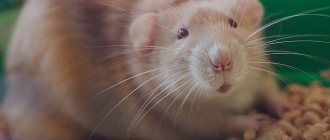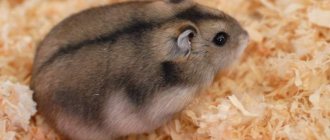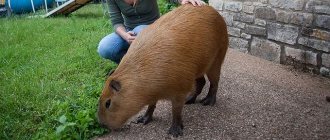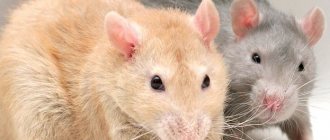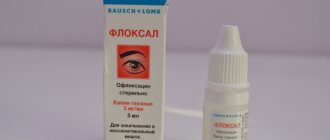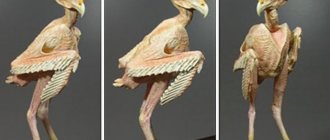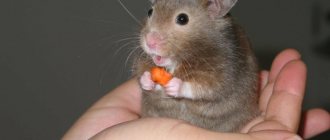In addition to a cage, drinking bowl, feeder and toys, hamsters require bedding or litter. Its quality determines how quickly a characteristic smell will appear in your pet’s house and how often cleaning will be needed.
And to figure out which fillers are best suited for hamsters, advice from experienced owners of small rodents will help.
Corn mat
The leader among litters for rodents of any breed, be it Djungarians or Syrian hamsters, is considered to be corn flooring, made from the cobs of an agricultural crop. The light and soft structure fits perfectly under the animal's paws and does not hurt or scratch.
Absorbs moisture perfectly and retains unpleasant odor for more than ten days. The filler is economical to use; a small layer is enough to completely cover the bottom. The material has no artificial or aromatic additives and is absolutely harmless if it penetrates the stomach of an animal.
Does not contain dust and does not cause allergies. Suitable for all breeds of hamsters. The flooring is recommended by veterinarians as a favorable bedding for newborn pets.
If corn filler had participated in the rating, it could have been given 1st place. The disadvantages are:
- High price.
- Sold only in large specialized stores.
- Easily scattered outside the cage.
Why does a hamster hibernate?
For cats
Natural cat material that does not contain dyes or additives is also suitable for bedding in a hamster cage. For example, a hamster will be comfortable in a cage with wood filling, which perfectly retains moisture and odors, while silicate or mineral varieties can harm the health of your beloved pets.
Advantages:
- easy to purchase;
- low price;
- good absorbent properties.
Flaws:
- must be completely natural.
Wood filler: pros and cons
Wood granular filler.
The optimal filling for the cage is wood filler or a smaller option - pressed sawdust. The material has good absorbent properties and is able to retain odor for a week.
Since the granules are quite heavy, the animal is not able to scatter them around the perimeter and around the cage. If you want to feast on the flooring, the rodent will not get hurt and will not stain its fur coat.
The product is environmentally friendly, but has several disadvantages.
- Wood filler is slightly more expensive than regular sawdust.
- The presence of wood dust, which provokes allergies.
- Inconvenience associated with the animal's movement on large pellets.
- When spot cleaning a cage, it is difficult to distinguish the contaminated area.
Wood sawdust
For a long time, sawdust has been a popular and affordable means of filling the bottom of a cage. This filler has many advantages, but there are also a number of disadvantages in this universal and relatively safe flooring for rodents.
Pros:
- Budget price and the ability to buy in any specialty store or supermarket.
- Various options for chip sizes and sizes.
- Soft and lightweight material for the construction of burrows.
Minuses:
- The presence of hard chips that can prick a rodent's paw or damage the cheek pouch during tasting.
- Inability to retain odor and moisture for a long time. Frequent replacement of the litter is required to avoid unpleasant odors.
- Lightness and airiness of the product. An active pet is able to scatter sawdust outside the cage, which provides for additional cleaning of the area.
- Possible occurrence of allergies. Excessively fine wood dust irritates the mucous membrane of the nose and eyes, which leads to sneezing and tearing.
- Wood fibers can get tangled in your pet's thick fur, making the fur coat look unsightly. Unscheduled grooming is required.
An important factor when choosing sawdust is what type of tree it was made from. It is believed that pine needle filler contains a large amount of heavy resins that can cause damage to the pet’s respiratory system.
Phenols released from resin absorb moisture well, but have a detrimental effect not only on the lungs, but also on all internal organs of the rodent, leading to chronic diseases and early death of the pet. Therefore, sawdust from coniferous trees is not recommended for permanent use.
Sawdust from industrially processed materials is also unacceptable. Chemical solutions used to refinish wood release toxins.
Safe flooring is sawdust from fruit trees that do not contain toxic resins and do not cause an allergic reaction. Sawdust from aspen, poplar, pear and apple have good performance.
Before changing the filler, it is advisable to dry the sawdust well and sift it from wood dust.
Disposal of used sawdust
Used sawdust sorbent is classified as ordinary household waste, so for disposal it is thrown into the garbage chute or into the trash container closest to the house. In practice, many people get lazy and flush a mixture of wood shavings, urine and feces down the toilet. Despite the fact that this material does not create problems with conditional “correct” flushing, frequent repetition of this action is still not recommended to avoid possible clogging.
Outside the city, it is best to reuse bedding or backfill based on natural ingredients such as wood or clay, but as a fertilizer. For this purpose, they are dumped on the street in a heap, where over time they completely rot, turning into humus.
Can I use cat litter?
If there is no special flooring for rodents, you can use litter for the cat family for a short period. The only condition is the use of wood pellets, without dyes and fragrances. When choosing, you need to study the information on the packaging in order to avoid a purchase that could harm your small pet:
- Silicate gel - causes poisoning if eaten, corrodes the skin upon contact. Unpolished edges can cut the paws. Has a bad effect on hair growth.
- Lumpy clay filler is easy to clean, but sticks to the animal’s paws and quickly spreads over the entire surface. The composition includes quartz dust, which is harmful to the health of the hamster.
How to toilet train a hamster?
Plastic houses
Plastic houses are in greatest demand among livestock farmers. They are quite durable and reliable, but some hamster owners claim that such housing is poorly ventilated. And another disadvantage of such a house is that while testing everything around it, the rodent can swallow plastic and get sick. But such opinions are wrong.
Modern plastic houses for hamsters are made of high-quality materials, they are safe for animals, easy to clean, simple and convenient to use. The price of plastic housing is quite acceptable for most livestock farmers (from 50 rubles). Such models are distinguished by a variety of shapes, layouts and colors. Pet stores sell "bedrooms" with windows, colorful roofs, balconies, stairs and other decorative elements.
Hay: a blanket of grass
Hay is closest to the natural habitat of rodents. If we remember that in nature hamsters live in the steppes, then hay is a natural filling for their burrows. But it is not suitable for domesticated individuals as a permanent cell filler. Stems that are too tough can damage delicate skin.
For variety, you can use a small amount of hay to build a nest, but as the main bedding, hay is not beneficial due to its inability to absorb animal urine.
For use in a cage, it is advisable to purchase hay in a store; plants that have been processed in production meet safety standards. Hand-picked and dried hay can retain accumulated dirt and excrement from other animals.
How does a hamster behave in the wild?
Why do pets need bedding?
The filler, produced from various components, is used as a sorbent, that is, it is intended to absorb liquids and retain odors. The specific method of use is determined by what species the pet belongs to:
Cats and small dogs are usually trained to relieve themselves in a litter tray installed in the far corner of the apartment. There they can do the job and bury the excrement, hiding the smell, as their ancient instinct requires of them. The choice of type and manufacturer of bedding will be greatly influenced by the preferences of a particular animal; the more comfortable it is, the less trouble the owner will have.
Small animals, such as hamsters, rats and other rodents, spend more time rummaging through the litter and find many more uses for it. Firstly, the material still acts as a sorbent and is used as a toilet. Secondly, rodents love to chew something from the litter, especially when it comes to sawdust or corn. Thirdly, part of the filler will inevitably be spent on arranging the hamster’s personal shelter.
To create comfort, bedding is also placed at the bottom of bird cages. Birds like to pick up straws and pellets in their beaks, rummage through the litter, and throw them around. However, most of the time they sit on perches, which means that what lies below is less important for them than for hamsters or guinea pigs.
Large animals like horses spend most of their lives in a stall. Consequently, their health, appearance, and mood directly depend on the bedding in the stable. Therefore, increased requirements for hypoallergenicity, antiseptic properties, and ease of cleaning are applied to the material. A significant criterion is the price of the bedding used due to the rapid consumption of raw materials.
Insidious cotton wool
It would be logical to assume that cotton wool made from natural material - cotton - is the safest bedding. What could be better than the softest, warmest and airiest cloud in which your pet will sweetly fall asleep?
Cotton wool can kill a pet.
Alas, from a safety point of view, keeping cotton wool in the house exposes your pet to mortal danger. Externally fragile cotton wool has strong enough fibers that a hamster can catch on with its paw and pull blood vessels, which will lead to tissue death and loss of a limb.
In addition, although cotton wool absorbs liquid, it does not retain it at all and spreads the smell of urine.
Wooden houses
Wood is an environmentally friendly material, and in the wild, “fluffies” often encounter it. Therefore, a wooden house is a good choice for a pet. The surface of such housing is rougher than that of a plastic one, which allows the hamster to climb up the wall to the roof.
In pet stores you can find “bedroom” models with a flat or shaped roof. Some wooden houses resemble an ordinary doghouse, only in miniature. However, more beautiful models are also sold, in the design of which ice cream sticks or other wooden elements are used.
Depending on the size of the housing and its design features, the cost of such a “bedroom” is quite affordable for most livestock farmers (60-100 rubles).
Alternative flooring options
What to do if the pet has already arrived at its permanent location, but the cage has not yet been equipped? For a temporary device, clean and soft paper napkins, without multi-colored patterns or fragrances, are suitable.
The animal will happily make a nest for itself to sleep in. But napkins have one significant drawback - the inability to retain urine and an unpleasant odor. For the comfort of the animal, you will have to clean the home often.
In addition to napkins, the hamster can be given non-scented toilet paper and paper towels that have a soft texture for nest building . It is not advisable to use drawing paper or notebook sheets. Hard edges can easily injure your pet.
You cannot use torn sheets of newspaper as bedding. A large amount of impurities in printing ink, when evaporated, can cause significant harm to the health of a pet.
Rules for arranging a home for a hamster
In nature, these animals live in burrows. So the domestic animal also needs an impromptu mink. He hides there and sleeps. Sometimes he can store food supplies in the house.
For large breeds of hamsters, carefully choose a cage so that the holes in it correspond to the size of the animal , otherwise it risks getting stuck in them.
Simple tips for creating a cozy place for your hamster inside the cage:
- Napkins or torn paper can serve as a house, from which the pet will make a nest for itself.
- Pieces of non-woolen fabric are placed in the house.
- You can buy ready-made nesting material for rodents.
- Periodically it is necessary to clean the hamster's house, and at the same time clear it of old food supplies.
Your pet feels more comfortable having a secluded place to retreat to..
Cleaning up the cage
Having a pet in the house means caring for and caring for the animal. Timely replacement of bedding has a beneficial effect on the viability of the rodent. Changing the flooring depends on the quality of the filler.
Naturally, the higher the absorbent properties, the less often you can clean. This will allow the pet not to experience stress during cleaning, and will make it easier for the owner to care for. When using sawdust or granules, the cage is cleaned once a week.
When cleaning, it is advisable to leave a small part of the soiled litter in place so that the hamster does not lose its scent.
Let's sum it up
Now you know which litter is best for hamsters and you can choose the right option for your pet with good value for money. We hope you have decided what sawdust is needed for hamsters specifically in your case. Theoretically, you can do without the filler, but with it the hamster is warmer, more comfortable, and it is more convenient for the owner to clean the cage. You need to choose pine sawdust with caution; it is acceptable to use pine sawdust, but cedar sawdust is not recommended. You cannot use sawdust from the factory, even from fruit trees, since before production the wood is treated with special compounds against pests.
Beginner hamster breeders are interested in the question of how much filler to lay. It is recommended in one layer, so that the bedding covers the bottom.
Sources:
https://xvostus.com/homyaki/uhod/napolnitel.html https://pets2.me/bok/1398-kakoy-napolnitel-luchshe-dlya-homyakov.html https://homkin.ru/soderjanie/napolnitel- dlya-homyakov.html
Why does a hamster bury itself in sawdust?
A hamster is a burrowing animal, and the fact that it digs up litter is in the order of things. In nature, hamsters are considered skilled builders of complex multi-level passages and burrows. Digging in the litter indicates the animal is in a good mood and maintaining its skills.
Perhaps the house is too small for him and the hamster prepares a cozy hole for himself in this way. In addition, digging serves as a preventive measure against parasites and for cleaning the fur coat. In an unadapted pet, digging may indicate a desire to hide. In any case, digging is a sign of normal hamster behavior.
It is also natural for the pet to bury itself in the litter. The dry and light filler serves as an excellent insulation for a frozen animal. The owner should move the cage to a dry, warm place without drafts.
Filling the cage is an important part for the good appearance and internal condition of the pet. The question is, which filler is best for hamsters? Most owners and veterinarians answer that it is corn. Although it is possible to please the rodent, you will need to try several types of litter. But is it worth it to keep the hamster healthy?
When do hamsters dream and why do they need a house?
In the wild, rodents like to build their nests in small shelters: hollows, burrows, recesses, nests. They are nocturnal; during the day, rodents like to sleep. To do this, they choose small spaces that provide the animals with safety, comfort and the necessary thermoregulation.
For pets, their owners have to take care of their comfort. In order for your pet to rest peacefully after nightly “walks” on the wheel, it is advisable to equip its cage with a small house.
In this case, two unforeseen situations may arise. If the hamster does not sleep in the house, there are reasons for this. As a rule, rodents reject housing whose smell they do not like. After washing the home, it should be placed in a place where the animal curls up and rests.
The hamster may simply be hot (especially in the summer), and he chose a more ventilated place. There is no need to worry that the hamster has stopped sleeping in the house if the animal is healthy, active and eats the food offered with appetite. Let him sleep where he is comfortable.
There are also the opposite cases: the pet has become so comfortable in its secluded place that it does not leave the house. This happens when the animal adapts to new conditions, or is very frightened. However, if the "fluffy" does not come out of hiding to eat or drink, then some kind of disease may be the cause. In this case, it is necessary to lure the hamster out of the house or carefully remove it from there by lifting the structure. The animal must be carefully examined and, at the slightest suspicion of illness, shown to a veterinarian.
